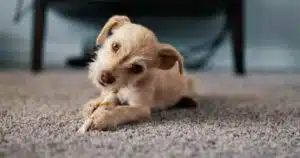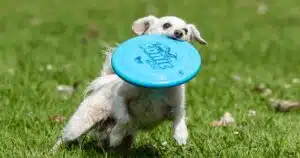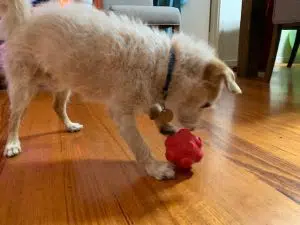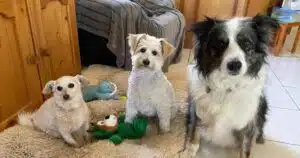
Many owners get frustrated by their dog’s over-excited or aggressive reaction to seeing another dog and are unsure of what to do about dog to dog reactivity or aggression.
Dog to dog aggression is often a fear based response, where they see the other dog as a perceived threat, and may be based on past negative experiences, a lack of socialisation during their critical period of development, anxiety and more.
Generally, most owners miss the early warning signs that their dog is feeling threatened or anxious and is preparing to react. They unknowingly push their dog past its ‘Alert Zone’ (where the dog begins to exhibit the signs and behaviours that indicate they are feeling uncomfortable/stressed, ie: yawning, lip licking, head and tail up etc.) and keep walking their dog into its reaction threshold, known as the ‘critical distance’ in training terms.
‘Critical distance’ is the area which differentiates between a dog reacting or not reacting towards a perceived threat. So, if an owner doesn’t notice the early warning signs and continues to move their dog to, or even past, their reactivity threshold/critical distance then it will almost always result in dog to dog reactivity or aggression. (e.g.: growling, staring, barking, lunging, etc).
This is the same for an over-excited dog to dog greeting, such as in the case of Tikka the Staffy in the video above. Due to Tikka’s forceful and over-excited response when seeing other dogs, he has been given up for adoption twice. Fortunately Derek, Tikka’s new owner, is committed to working on this and is doing a great job with him.
As I’ve discussed before, if a dog is allowed to continue with a behaviour and is rewarded for it, it will be reinforced and continue with more frequency and intensity.
In the case of fear based aggression, the ‘reward’ could be the other dog running away/owners keeping them apart etc.; whilst for an over excited dog to dog greeting, the ‘reward’ could be the dog being allowed to rush up to the other dog. That is why it is important that these reactions are not allowed to continue and are addressed as early as possible.
To help address dog to dog reactivity and aggression with training, it definitely requires the assistance of an experienced trainer to help ensure you keep your dog just under its reactivity threshold to assist with the behaviour modification (rehabilitation) process.
A full assessment of the reaction is also needed to determine if it is a fear based response or a genetic disposition to aggression, as it is vital that the right behaviour modification technique is used so that the problem can be improved and not made worse. For example, using punishment as a correction for a dog with fear-based aggression could make their fear, and response to other dogs, far worse!
This includes desensitising the dog to the ‘trigger’ (another dog in this case) which removes the emotional response to other dogs by way of repeated and controlled exposure, and is done slowly and methodically so that your dog feels like he is in control of the situation at all time.
We also use ‘counter conditioning’ where we condition or replace the undesirable behaviour (aggression or over excitement/reactivity) with another more desirable behaviour, by creating a positive emotional association when seeing another dog.
In Tikka’s case, we were not dealing with fear aggression, but rather dog to dog reactivity due to over-stimulation. So for the purposes of this article I will outline some steps/tips based on Behaviour Adjustment Training (BAT) to help with reactivity in general.
In the case of dog to dog reactivity, it is good to use ‘distance’ as the functional reward for the reactive dog. Treats can be a bonus reward.
Before embarking on a behaviour modification process for dog to dog issues, you must first establish your dog’s critical distance (or reactivity threshold) as we need to work in the area where your dog is alert but not reacting.
Step 1: Stop when your dog is at a safe distance (sub-threshold)
For example, if you are out walking your dog on a loose lead and they see another dog, they are still within their threshold even if they start to lean forward, stare at the other dog, go stiff, tense or their ears go up. These early signals means they are in their ‘Alert Zone’ (which is where we want them), but have not yet reached their reactivity threshold (which is when they would start lunging, growling, barking etc. and is NOT what we want).
Step 2: Dog looks at other dog and makes a peaceful or good choice and ‘mark’ it.
Whilst you are in the ‘Alert Zone’ where they are aware and alert about the other dog, but haven’t yet reacted, as soon as they turn around to look at you (‘look at me’) or start to sniff the ground, lick or yawn (early indication of fear or anxiety kicking in) or respond to a ‘Sit’ command, you would then ‘mark’ that desired response with the conditioned reinforcer ie: ‘yes’ or ‘clicker’.
Step 3: Immediately give them their functional reward = Distance
Upon the dog making that good or peaceful choice (ie: not reacting further to the other dog) and marking it, we then immediately remove them from the trigger – in this case we’d turn and increase the distance between your dog and the other dog. Praise and pats once you have ‘marked it’ also reward them for making that right choice and not reacting.
Step 4: Optional/Bonus Reward = TREAT
This would come after you have applied the functional reward (which is giving your dog greater distance) to really reinforce that desired response.
Step 5: Process is repeated and the threshold is slowly closed
If done properly there should be no dog to dog reactivity , but it must be set up and practiced with a calm trigger dog or in a class of controlled dogs.
This process worked really well with Tikka, where he can now attend group classes and is less stimulated by the other dogs and can actually do some class training with them. This is largely because his owner Derek is committed to the cause and enlisted the services of Trish Harris from Four Paws K9 training, who is an experienced and NDTF qualified trainer to help.
About the Author: Lara Shannon is a certified dog behaviourist and trainer, pet food nutrition specialist, Executive Producer and Host of Pooches at Play on Channel 10 and editor of Poochesatplay.com. Lara also runs her own dog training business in Melbourne’s Bayside area and is the Author of World of Dogs and Eat, Play, Love Your Dog



Brain games for dogs – Treat Treasure Hunt


Debunking common dog and cat myths


Get your paws on Lara Shannon’s best selling books ‘Eat, Play, Love (your dog) and World of Dogs.
Available in Australia, USA, UK and Canada.